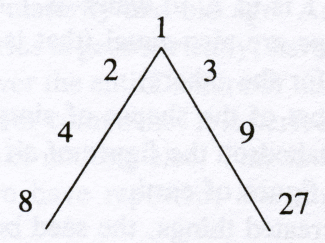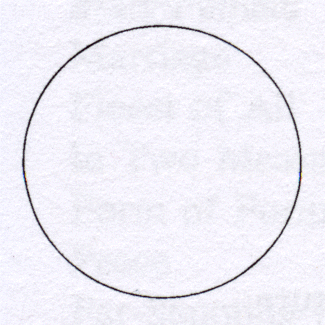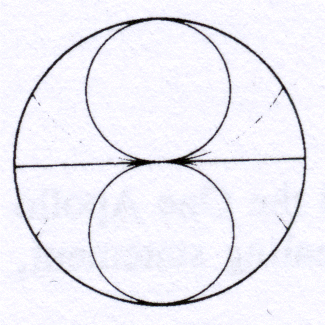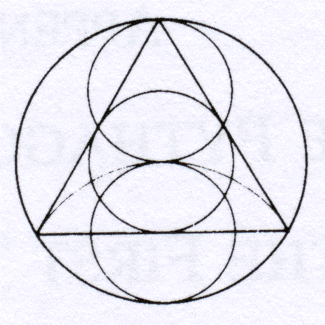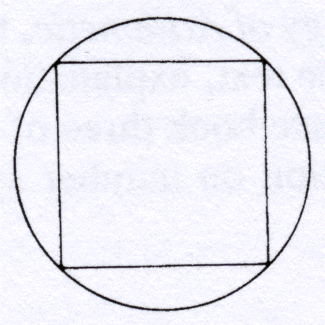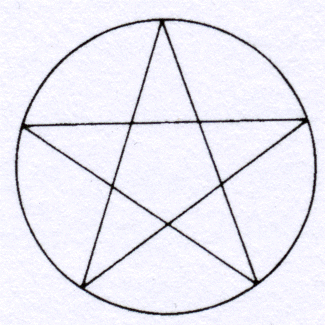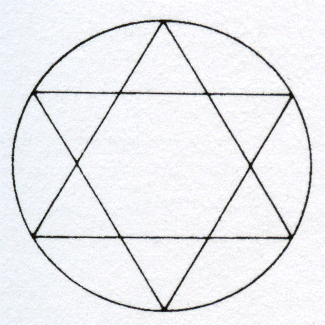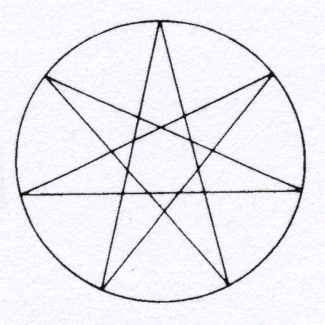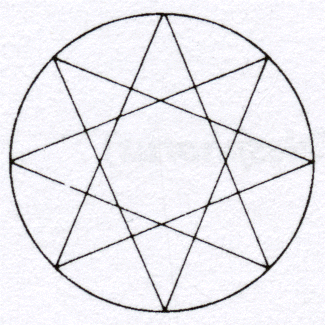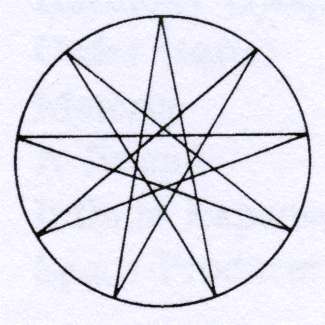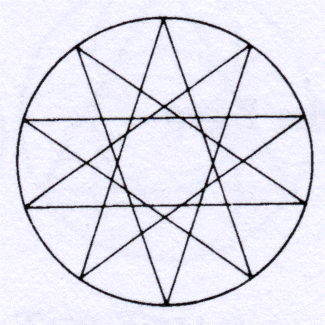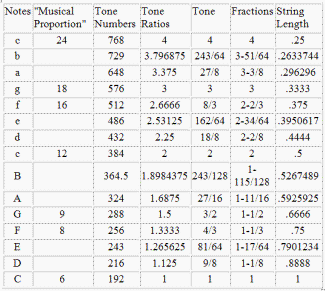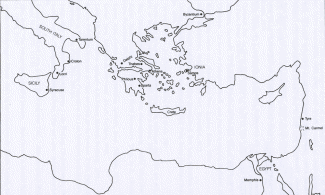TRANSLATED BY ARTHUR FAIRBANKS
THE WRITINGS of the doxographers, the Vetusta Placita of Aetius, the Placita Philosophorum attributed to Plutarch, and so on, ultimately derive from a work of Theophrastus, Physikon Doxon. "Opinions of the Natural Philosophers." In this work Theophrastus compiled information on the doctrines of different philosophers by subject, serving to compare and contrast them with one another.
The fragments of the doxographers were collected together and published by Hermann Diels as Doxographi Graeci, Berlin, 1879, and the corresponding numeration of Diels' edition is reproduced at the beginning of each fragment. These fragments relating to the Pythagoreans, like the preceding passages from Plato and Aristotle, are translated by Arthur Fairbanks and reproduced from his The First Philosophers of Greece: An Edition and Translation of the Remaining Fragments of the Pre-Sokratic Philosophers, Together with a Translation of the More Important Accounts of their Opinions Contained in the Early Epitomes of their Works, New York, Charles Scribner's Sons, 1898.
FRAGMENTS FROM THE DOXOGRAPHERS
Aetius, Plac. i. 3; Dox. 280. And again from another starting-point, Pythagoras, son of Mnesarchus, a Samian, who was the first to call this matter by the name of philosophy, assumed as first principles the numbers and the symmetries existing in them, which he calls harmonies, and the elements compounded of both, that are called geometrical. And again he includes the Monad and the Indefinite Dyad among the first principles; and for him one of the first principles tends toward the creative and form-giving cause, which is intelligence, that is God, and the other tends toward the passive and material cause, which is the visible universe. And he says that the starting-point of Number is the Decad; for all Greeks and all barbarians count as far as ten, and when they get as far as this they return to the monad. And again, he says, the power of ten is in four and the tetrad. And the reason is this: if anyone from the monad adds the numbers in a series as far as four, he will fill out the number ten [i .e., 1 + 2 + 3 + 4 = 10], but if he goes beyond the number of the tetrad, he will exceed ten. Just as if one should add one and two and should add to these three and four, he will fill out the number ten; so that according to the monad number [actually] is in the ten, but potentially in the four. Wherefore the Pythagoreans were wont to speak as though the greatest oath were the Tetrad:
By him that transmitted to our soul the Tetraktys,
The spring and root of ever-flowing nature.
And our soul, he says, is composed of the Tetrad, for this is intelligence, understanding, opinion, and sense, from which things come every art and science, and we ourselves become reasoning beings. The Monad, however, is intelligence, for intelligence sees according to the Monad. As for example, men are made up of many parts, and part by part they are devoid of sense and comprehension and experience, yet we perceive that man as one alone, whom no being resembles, possessing these qualities; and we perceive that a horse is one, but part by part it is without experience. For these are forms and classes according to monads. Wherefore, assigning this limit with reference to each one of these, they speak of a reasoning being and a neighing being. On this account then the Monad is intelligence by which we perceive these things. And the Indefinite Dyad is fittingly science, for all proof and persuasion is part of science, and further every syllogism brings together what is questioned out of some things that are agreed upon, and easily proves something else; and science is the comprehension of these things, wherefore it would be the Dyad. And opinion as the result of comprehending them is fittingly the Triad, for opinion has to do with many things, and the Triad is quantity, as 'The thrice-blessed Danaoi.' On this account then he includes the Triad... And their sect is called Italic because Pythagoras taught in Italy, having left Samos, his fatherland, of dissatisfied with the tyranny of Polycrates.
i. 7; Dox. 302. Pythagoras held that one of the first principles, the Monad, is God and the Good, which is the origin of the One, and is itself Intelligence, but the Indefinite Dyad is a daimon and bad, surrounding which is the mass of matter.
i. 8; Dox. 307. Divine spirits (daimones) are psychical beings, and heroes are souls separated from bodies; good heroes are good souls, bad heroes are bad souls.
i. 9; Dox. 307. The followers of Thales and Pythagoras and the Stoics held that matter is variable and changeable and transformable and is in a state of flux, the whole through the whole.
i. 10; Dox. 309. Pythagoras asserted that the so-called forms and ideas exist in numbers and their harmonies, and in what are called geometrical objects, apart from bodies.
i. 11; Dox. 310. Pythagoras and Aristotle asserted that the first causes are immaterial, but that other causes involve a union or contact with material substance [so that the world is material].
i. 14; Dox. 312. The followers of Pythagoras held that the universe is a sphere according to the form of the four elements, but the highest, fire, alone is conical.
i. 15; Dox. 314. The Pythagoreans call color the manifestation of matter.
i. 16; Dox. 314. Bodies are subject to change of condition, and are divisible to infinity.
i. 18; Dox. 316. (After a quotation from Aristotle, Physics, iv. 4; 212 a 20.) And in his first book on the philosophy of Pythagoras he writes that the heaven is one, and that time and wind and the void which always defines the places of each thing, are introduced from the infinite. And among other things he says that place is the immovable Limit of what surrounds the world, or that in which bodies abide and are moved, and that it is full when it surrounds body on every side, and empty when it has absolutely nothing in itself. Accordingly it is necessary for place to exist, and body, and it is never empty except from the standpoint of thought, for the nature of it in perpetuity destroys the interrelation of things and the combination of bodies; motions arise according to the place of bodies that surround and oppose each other, and no infiniteness is lacking, either of quality or of extent.
i. 20; Dox. 318. Pythagoras said that time is the sphere which surrounds the world.
i. 21; Dox. 318. Pythagoras. Plato: Motion is a certain otherness or difference in matter.
i. 24; Dox. 320. Pythagoras, and all that assume matter is subject to change, assert that genesis and destruction in an absolute sense take place, for from change of the elements, modification and separation of them there takes place juxtaposition and mixture, and intermingling and melting together.
Aetius, Plac. ii. l; Dox. 327. Pythagoras first named the circumference of all things the kosmos by reason of the order in it.
ii. 4; Dox. 330. Pythagoras, Plato, and the Stoics held that the universe is brought into being by God. And it is perishable so far as its nature is concerned, for it is perceived by sense, and therefore material; it will not however be destroyed in accordance with the foreknowledge and plan of God.
ii. 6; Dox. 334. Pythagoras: The universe is made from five solid figures which are also called mathematical; of these he says that earth has arisen from the cube, fire from the pyramid, air from the octahedron, and water from the icosahedron, and the sphere of the All from the dodecahedron.
ii. 9; Dox. 338. The followers of Pythagoras hold that there is a void outside the universe into which the universe breathes forth, and from which it breathes in.
ii. 10; Dox. 339. Pythagoras, Plato, Aristotle: The right hand side of the universe is the eastern part from which comes the beginning of motion, and the left hand side is the west. They say the universe has neither height nor depth, in which statement height means distance from below upwards, and depth from above downwards. For none of the distance thus described exists for the universe, inasmuch as it is disposed around the middle of itself, from which it extends toward the All, and with reference to which it is the same on every side.
ii. 12; Dox. 340. Thales, Pythagoras, and their followers: The sphere of the whole heaven is divided into five circles which they call zones; the first of these is called the arctic zone and is ever visible, the second the summer solstice, the third the equinoctial, the fourth the winter solstice, and the fifth the antarctic zone, which is invisible. And the ecliptic called the zodiac in the three middle ones is projected to touch the three middle ones. And the meridian crosses all these from the north to the opposite quarter at right angles. It is said that Pythagoras was the first to recognize the slant of the zodiacal circle which Oenopides of Chios appropriated as his own discovery.
ii. 13; Dox. 343. Heracleides and the Pythagoreans asserted that each world of the stars is air and aether surrounding earth in the infinite aether. And these doctrines are brought out in the Orphic writings, for they [likewise] construct each world of the stars.
ii. 22; Dox. 352. The Pythagoreans: The sun is spherical.
ii. 23; Dox. 353. Plato, Pythagoras, Aristotle: The solstices lie along the slant of the zodiacal circle, through which the sun goes along the zodiac, and with the accompaniment of the tropical circles, and all these things the globe also shows.
ii. 24; Dox. 354. An eclipse takes place when the moon comes past.
ii. 25; Dox. 357. Pythagoras: The moon is a mirror-like body.
ii. 29; Dox. 360. Some of the Pythagoreans (according to the Aristotelian account and Philip of Opus) said that an eclipse of the moon takes place sometimes by the interposition of the earth, sometimes by the interposition of the counterearth (antichthon). But it seems to some more recent thinkers that it takes place by a spreading of the flame little by little as it is gradually kindled, until it gives the complete full moon, and again, in like manner, it grows less until the conjunction, when it is completely extinguished.
ii. 30; Dox. 361. Some of the Pythagoreans, among them Philolaus, said that the earthy appearance of the moon is due to its being inhabited by animals and by plants, like those on our earth, only greater and more beautiful; for the animals on it are fifteen times as powerful, not having any sort of excrement, and their day is fifteen times as long as ours. But others said that the outward appearance in the moon is a reflection on the other side of the inflamed circle of the sea that is on our earth.
ii. 32; Dox. 364. Some regard the greater year...as the sixty year period, among whom are Oenopides and Pythagoras.
Aetius, Plac. iii. 1; Dox. 364. Some of the Pythagoreans said that the Milky Way is the burning of a star that fell from its own foundation, setting on fire the region through which it passed in a circle, as Phaethon was burned. And others say that the course of the sun arose in this manner at the first. And certain ones say that the appearance of the sun is like a mirror reflecting its rays toward the heaven, and therefore it happens at times to reflect its rays on the rainbow in the clouds.
iii. 2; Dox. 366. Some of the followers of Pythagoras say that a comet is one of the stars which are not always shining, but which emit their light periodically through a certain definite time; but others say that it is the reflection of our vision into the sun, like reflected images.
iii. 14; Dox. 378. Pythagoras: The earth, after the analogy of the sphere of the All, is divided into five zones, arctic, antarctic, summer, winter and equinoctial; of these the middle one he defines to be the middle of the earth, called for this very reason the torrid zone, the inhabited one [the one between the arctic and the torrid zones] being well-tempered...
Aetius, Plac. iv. 2; Dox. 386. Pythagoras holds that number moves itself, and he takes number as an equivalent for intelligence.
iv. 4, Dox. 389. Pythagoras, Plato: According to a superficial account the soul is of two parts, the one possessing, the other lacking, reason; but according to close and exact examination, of three parts, for the unreasoning part they divide into the emotion and the desires.
Theodor. v. 20; Dox. 390. The successors of Pythagoras saying that the body is a mixture of five elements (for they ranked aether as a fifth along with the four), held that the powers of the soul are of the same number as these. And these they named intelligence and wisdom and understanding and opinion and sense-perception.
Aetius, Plac. iv. 5; Dox. 391. Pythagoras: The principle of life is about the heart, but the principle of reason and intelligence is about the head.
iv. 5; Dox. 392. Pythagoras, et al.: The intelligence enters from without.
iv. 7; Dox. 392. Pythagoras, Plato: The soul is imperishable.
iv. 9; Dox. 396. Pythagoras, et al.: The sense-perceptions are deceptive.
iv. 9; Dox. 397. Pythagoras, Plato: Each of the sensations is pure, proceeding from each single element. With reference to vision, it is of the nature of aether; hearing, of the nature of wind; smell, of the nature of fire; taste, of the nature of moisture; touch, of the nature of earth.
iv. 14; Dox. 405. The followers of Pythagoras and of the mathematicians on reflections of vision: For vision moves directly as it were against the bronze [of a mirror], and meeting with a firm, smooth surface, it is turned and bent back on itself, meeting some such experience as when the arm is extended and then bent back to the shoulder.
iv. 20; Dox. 409. Pythagoras, Plato, Aristotle: Sound is immaterial. For it is not air, but it is the form about the air and the appearance (epiphaneia) after some sort of percussion which becomes sound; and every appearance is immaterial, for it moves with bodies, but is itself absolutely immaterial, as in the case of a bent rod the surface appearance suffers no change, but the matter is what is bent.
Aetius, Plac. v. 1; Dox. 415. Pythagoras did not admit the sacrificial part alone (of augury).
v. 3; Dox. 417. Pythagoras: Sperm is foam of the best part of the blood, a secretion from the nourishment, like blood and marrow.
v. 4; Dox. 417. Pythagoras, Plato, Aristotle: The power of seed is immaterial, like intelligence, the moving power; but the matter that is poured forth is material.
v. 20; Dox. 432. Pythagoras, Plato: The souls of animals called unreasoning are reasonable, not however with active reasoning powers, because of an imperfect mixture of the bodies and because they do not have the power of speech, as is the case of apes and dogs, for these have intelligence but not the power of speech.
Ar. Did. Ep. Fr. 32; Dox. 467. Apollodorus in the second book Concerning the Gods: It is the Pythagorean opinion that the morning and the evening star are the same.
Theophr. Phys. Op. Fr. 17; Dox. 492. Favorinus says that he [Pythagoras] was the first to call the heavens a kosmos and the earth spherical.
Cic., de Deor. Nat., i. 11; Philod., Piet. Fr. c 4 b; Dox. 533. For Pythagoras, who held that soul is extended through all the nature of things and mingled with them, and that from this our souls are taken, did not see that God would be separated and torn apart by the separation of human souls; and when souls are wretched, as might happen to many, then part of God would be wretched -- a thing which could not happen.
Hippol., Phil. 2; Dox. 555. There is a second philosophy not far distant from the same time, of which Pythagoras, whom some call a Samian, was the first representative. And this they call the Italian philosophy because Pythagoras fled the rule of Polycrates over the Samians and settled in an Italian city where he spent his life. The successive leaders of this sect shared the same spirit. And he in his studies of nature mingled astronomy and geometry and music [and arithmetic]. And thus he asserted that God is a monad, and examining the nature of number with especial care, he said that the kosmos produces melody and is put together with harmony, and he first proved the motion of the seven stars to be rhythm and melody. And in wonder at the structure of the universe, he decreed that at first his disciples should be silent, as if they were mystae who were coming into the order of the All; then when he thought they had sufficient education in the principles of truth, and had sought wisdom sufficiently in regard to stars and in regard to nature, he pronounced them pure and then bade them to speak. He separated his disciples into two groups, and called one esoteric, and the other exoteric. To the former he entrusted the more perfect sciences, to the latter the more moderate. And he dealt with magic, as they say, and himself discovered the art of physiognomy. Postulating both numbers and measures he was wont to say that the first principle of arithmetic embraced philosophy by combination, after the following manner:
Number is the first principle, a thing which is undefined, incomprehensible, having in itself all numbers which could reach infinity in amount. And the first principle of numbers is in substance the first Monad, which is a male monad, begetting as a father all other numbers. Secondly the Dyad is a female number, and the same is called by the arithmeticians even. Thirdly the Triad is a male number; this the arithmeticians have been wont to call odd. Finally, the Tetrad is a female number, and the same is called even because it is female.
All numbers, then, taken by classes are four -- but number is undefined in reference to class -- of which is composed the perfect number, the Decad. For the series one, two, three and four becomes ten, and its own name is kept in its essence by each of the numbers. Pythagoras said that this sacred Tetraktys is "the spring having the roots of ever-flowing nature" in itself, and from this numbers have their first principle. For the eleven and the twelve and the rest derive from the ten the first principle of their being. The four parts of the Decad, this perfect number, are called number, monad, power and cube. And the interweavings and minglings of these in the origin of growth are what naturally completes nascent number; for when a power is multiplied upon itself, it is the power of a power; and when a power is multiplied on a cube, it is the power of a cube; and when a cube is multiplied on a cube, the cube of a cube; thus all numbers, from which arise the genesis of what arises, are seven: number, monad, power, cube, power of a power, power of a cube, and cube of a cube.
He said that the soul is immortal, and that it changes from one body to another; so he was wont to say that he himself had been born before the Trojan war as Aethalides, and at the time of the Trojan war as Euphorbus, and after that as Hermontimus of Samos, then as Pyrrhos of Delos, fifth as Pythagoras. And Diodorus of Eretria and Aristoxenus the musician say that Pythagoras had come unto Zaratas of Chaldaea [i.e., Zoroaster]; and he set forth that in his view there were from the beginning two causes of things: father and mother. The father is light and the mother darkness; and the parts of light are warm, dry, light, swift; and of darkness are cold, moist, heavy, slow; and of all these the universe is composed, of male and female. And he says that the universe exists in accordance with musical harmony, so the sun also makes an harmonious period. And concerning the things that arise from the earth and the universe they say Zaratas spoke as follows: There are two divinities, one of the heavens and the other of the earth; the one of the earth produces things from the earth, and it is water; and the divinity of the heavens is fire with a portion of air, warm, and cold; wherefore he says that none of these things will destroy or even pollute the soul, for these are the essence of all things. And it is said that Zaratas forbade men to eat beans because he said that at the beginning and composition of all things when the earth was still a whole, the bean arose. And he says that the proof of this is that if one chews a bean to a pulp and exposes it to the sun for a certain time (for the sun will affect it quickly), it gives off the odor of human seed. And he says that there is another and clearer proof: if when a bean is in flower we were to take the bean and its flower, and putting it into a pitcher moisten it and then bury it in the earth, and after a few days dig it up again, we should see in the first place that it had the form of a womb, and examining it closely we should find the head of a child growing with it.
Pythagoras perished in a conflagration with his disciples in Croton in Italy. And it was the custom when one became a disciple to burn one's property and to leave one's money under a seal with Pythagoras, and one remained in silence sometimes three years, and sometimes five years, and studied. And immediately on being released from this one mingled with the others and continued as a disciple and made one's home with them; otherwise one took one's money and was sent off. The esoteric class were called Pythagoreans, and the others Pythagoristians. And those of the disciples who escaped the conflagration were Lysis and Archippus and Zalmoxis the slave of Pythagoras, who is said to have taught the Pythagorean philosophy to the Druids among the Celts. It is said that Pythagoras learned numbers and measures from the Egyptians. Astonished at the wisdom of the priests, which was deserving of belief and full of fancies and difficult to grasp, he imitated it and himself also taught his disciples to be silent, and obliged the student to remain quietly in rooms underneath the earth.
Epiph. Pro. i; Dox. 587. Pythagoras laid down the doctrine of the Monad and of foreknowledge and the prohibition on sacrificing to the Gods then believed in, and he bade men not to partake of beings that had life, and to refrain from wine. And he drew a line between the things from the moon upwards, calling these immortal, and those below, which he called mortal; and he taught the transmigration of souls from bodies into bodies even as far as animals and beasts. And he used to teach his followers to observe silence for a period of five years. Finally he named himself a God. [1]
Epiph. Haer. iii. 8; Dox. 390. Pythagoras the Samian, son of Mnesarchus, said that the Monad is God, and that nothing has been brought into being apart from this. He was wont to say that wise men ought not to sacrifice animals to the Gods, nor yet to eat what had life, nor beans, nor to drink wine. And he was wont to say that all things from the moon downward were subject to change, while from the moon upward they were not. And he said that the soul goes at death into other animals. And he bade his disciples to keep silence for a period of five years, and finally he named himself a God.
Herm. I.G.P. 16; Dox. 655. Others then from the ancient tribe, Pythagoras and his fellow tribesmen, revered and taciturn, transmitted other dogmas to me as mysteries, and this is the great and unspeakable ipse dixit: the Monad is the first principle of all things. From its forms and from numbers the elements arose. And he declared that the number, form and measure of each of these is somehow as follows: Fire is composed of twenty-four right-angled triangles, surrounded by four equilaterals. And each equilateral consists of six right- angled triangles, whence they compare it to the pyramid. Air is composed of forty-eight triangles, surrounded by eight equilaterals. And it is compared to the octahedron, which is surrounded by eight equilateral triangles, each of which is separated into six right-angled triangles so as to become forty-eight in all. And water is composed of one hundred and twenty triangles, surrounded by twenty equilaterals, and it is compared to the icosahedron, which is composed of one hundred and twenty equilateral triangle. And aither is composed of twelve equilateral pentagons, and is like a dodecahedron. And earth is composed of forty-eight triangles, and is surrounded by six equilateral tetragons, and it is like a cube. For the cube is surrounded by six tetragons, each of which is separated into eight triangles, so that they become in all forty-eight.
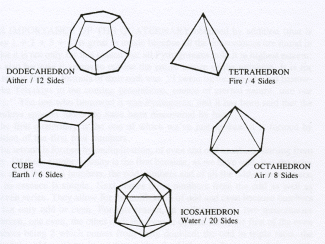
FIGURE 16. THE REGULAR SOLIDS. The regular solids, also known as the Platonic solids, were first described by Plato in his Timaeus. Plato identified the dodecahedron with the cosmic sphere (later identified with aither), and the four other solids with the four elements. Each one of the elemental "molecules" is constructed out of the triangular "atoms" shown below. The five regular solids are the only polyhedra that can be constructed out of the same regular polygons. The archetypal ratios and geometries with which they are associated underlie the structure and divisions of three-dimensional space.
DODECAHEDRON: Aither / 12 Sides
TETRAHEDRON: Fire / 4 Sides
CUBE: Earth / 6 Sides
OCTAHEDRON: Air / 8 Sides
ICOSAHEDRON : Water / 20 Sides
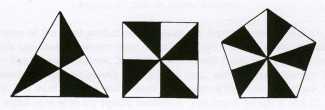
_______________
Notes:
1. While Pythagoras may have thought of himself as having some type of special relationship with the God Apollo, there is no reason to believe that he ever thought of himself as being a God. In fact, other church fathers attributed to Pythagoras a statement which challenged any man who thought himself a God to create a universe.

